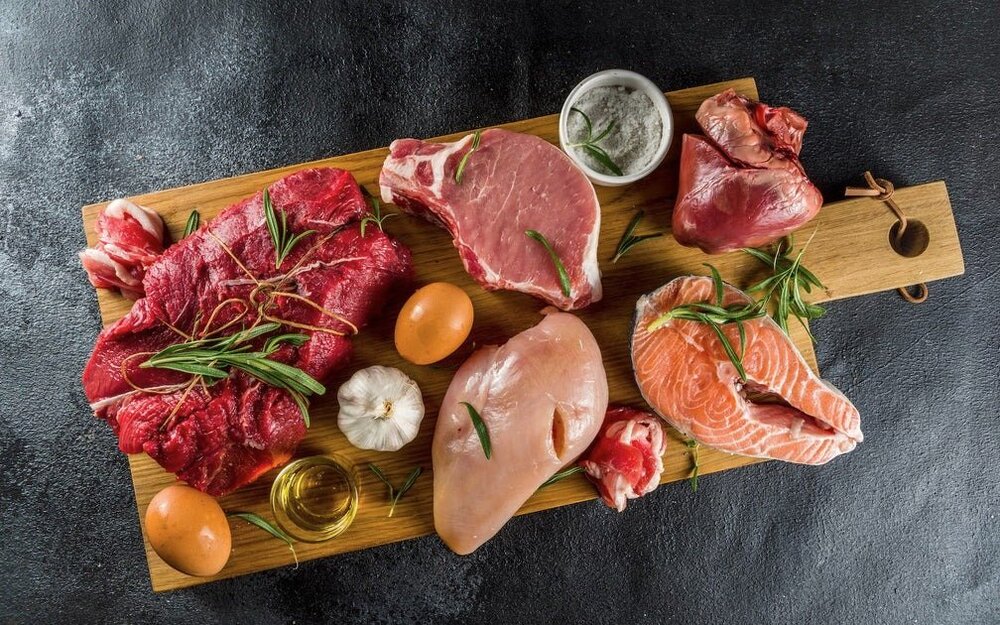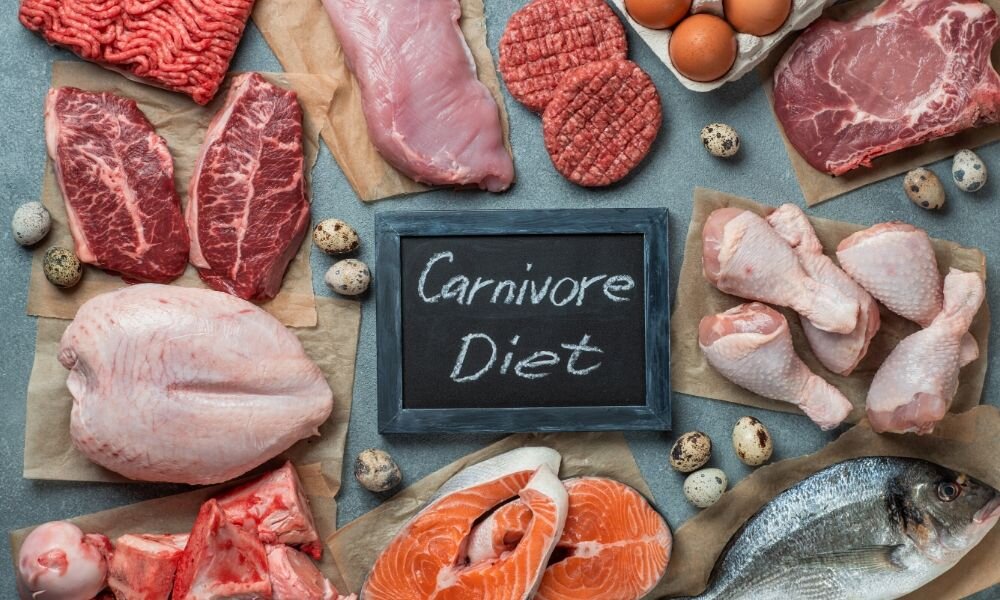.
This article is going to cover everything you need to know in order to get started on the Carnivore Diet and for you to personally become one of the many success stories resulting from this way of eating. So if you're thinking about starting the Carnivore Diet and not sure where to begin then keep reading and we will walk you through it.
What is the carnivore diet?
The Carnivore Diet is an all meat diet, also known as the meat only diet, zero carb diet, beef only diet, or Lion Diet depending on which version works best for you. You eat only animals and animal products and no plants whatsoever. That’s right. No obvious bad guys like sugar and grain, but also no vegetables, fruits, or nuts. Speaking of nuts, this probably sounds a bit nuts the first time you hear it, right? Well, if you take the time to do the research and understand the science and history behind eating this way, the more it’s going to make sense as you break it down.
Why does it work?
There are many reasons why the Carnivore Diet is effective for weight loss and optimizing one’s health. For starters, the Carnivore Diet is the ultimate ketogenic diet, which has been proven time and again to be one of the healthiest ways of eating in order to lose weight and reverse chronic disease. When you are eating only animal foods and no plant foods you are basically consuming zero carbs, or at least very minimal carbs, and so you experience a lot of the same benefits as you would on Keto. You will lose weight, regulate your blood sugar, and enjoy sustained energy and mental clarity.
Animal-based foods are the most nutrient-dense foods on the planet. That’s right, more nutritious than any plant or plant food combination. The proteins are complete, and the vitamins are more bio-available than what you find in plants. There are also anti-nutrients found in plants that inhibit the absorption of the little nutrition within them, a problem you never encounter when eating meat. Many plants also produce self-defense chemicals to deter bugs and other animals from eating them, and so by eliminating these foods you avoid the toxins that can trigger inflammation and autoimmune symptoms.
So, what can you eat?
 In its simplest form, only meat. But many carnivore dieters will allow for anything that comes from an animal, such as butter and cheese. You want to minimize dairy and focus on eating mostly meat and organ meats, which are loaded with vitamins and minerals. Beef is the most nutritious food for a human on the planet, but you can also enjoy eggs, seafood, chicken, and pork, including bacon.
In its simplest form, only meat. But many carnivore dieters will allow for anything that comes from an animal, such as butter and cheese. You want to minimize dairy and focus on eating mostly meat and organ meats, which are loaded with vitamins and minerals. Beef is the most nutritious food for a human on the planet, but you can also enjoy eggs, seafood, chicken, and pork, including bacon.
There is no need for supplementation, and you certainly will not be eating plant-based proteins or protein powders. Just focus on eating fatty cuts of meat. Lean meat is okay, but you need to consume fat for energy and to enjoy feeling satisfied for several hours at a time.
Tips for getting started
Tip #1: Ease into it
There are several ways to get started. For starters, there WILL be an adaptation phase as your body transitions to consuming an all meat (or meat-based, meat-heavy) diet. If you have been consuming the high sugar, high carbohydrate diet recommended by the USDA’s MyPlate Guidelines (formerly the Food Pyramid), you are going to experience withdrawal symptoms. Just like an addiction to drugs, humans get addicted to sugar and carbohydrates from ultra processed food. Coming off of sugar and carbs can be very similar to coming off of an addictive drug.
With this in mind, you may want to ease into this way of eating by starting with a Keto diet for at least a couple weeks. A true keto diet consists of only meat and low carb vegetables and no grain, no sugar, and no sugar substitutes. Don’t count or limit your carbs during this first 2 weeks, just focus on eating whole foods that went from farm to table without passing through a processing plant. Then for week 3, start counting your actual carbs and capping your daily carb intake at 20g or less. On week 4, cap that carb count at 10g or less. Then on week 5, remove all vegetation and focus on eating only animal products.
There will be no longer any need to count carbs because the carbs you do consume will be trivial (eggs have carbs, so do scallops, etc). You will have already been in ketosis for some time and fat adapted and your adaptation phase will be short lived or maybe even non-existent.
Tip #2: Give it at least 30 days
We would encourage you to commit to a minimum of 30 days. Don’t expect to eat carnivore for a few days or a couple weeks and expect to see drastic results. You may notice some benefits of a carnivore diet within just a few days, but many of the major benefits take several weeks to several months to become manifest. This is why you should do at least a personal 30 day “Carnivore Challenge” and then at the end of that month extend it to 60 or 90 days. The longer you stick to the carnivore lifestyle the more results you will see when it comes to any weight or health issues you may have.
Tip #3: Join the community!
You will want to connect with others who are also choosing to use keto or carnivore to optimize their health and lose weight. It is wonderful to have a support group when the people around you in real life, your family or friends, aren't on board with your new lifestyle. Thanks to the plant-based propaganda that has proliferated over the last several decades, there will be those who think that what you're doing is completely crazy. This may even include your doctor who was classically trained to believe that saturated fat and meat is bad. In actuality, this is what our ancestors thrived on, and isn’t too far off from what your grandparents were eating just a couple of generations ago.
CarnivoreTalk.com was created to be just that kind of community where you can find encouragement, support, and ask questions and get answers. We love to talk about Carnivore, which is why we call ourselves “CarnivoreTalk”. Whether it is in the forums or in our Zoom meetings, you can get the help you need to stay the course, as well as the medical and scientific research to back up what you are doing for the sake of your health.
4. Eat Until Full
 When you do sit down to enjoy your tasty carnivore meal, you want to make sure to eat until you are full and satisfied, but not in any kind of pain nor any feeling of being overstuffed. “Comfortably stuffed” is what you’re looking for. What is really nice about this lifestyle is that there is no calorie counting and no portion control on a carnivore diet. You shouldn’t have to concern yourself with counting macros. Why? Because your ancestors didn’t bother with all that recording and math. They just ate and were healthy. So, aim for 2 or 3 satisfying meals each day full of fatty meat and you will find that you don’t get hungry as much as you’re used to being on high carbohydrate diet.
When you do sit down to enjoy your tasty carnivore meal, you want to make sure to eat until you are full and satisfied, but not in any kind of pain nor any feeling of being overstuffed. “Comfortably stuffed” is what you’re looking for. What is really nice about this lifestyle is that there is no calorie counting and no portion control on a carnivore diet. You shouldn’t have to concern yourself with counting macros. Why? Because your ancestors didn’t bother with all that recording and math. They just ate and were healthy. So, aim for 2 or 3 satisfying meals each day full of fatty meat and you will find that you don’t get hungry as much as you’re used to being on high carbohydrate diet.
You are going to encounter this one problem at the beginning. As you fill up on mostly protein and fat from the meat and eggs that make up the bulk of your diet now, you’re going to not feel hungry as often. This is good in that you won’t be tempted to snack in between meals, and that’s a good thing. You don’t want to do that. But this never being hungry can be bad in that you might start unwittingly portion controlling. Don’t eat a small portion and assume that this is enough. You want to eat until you are comfortably stuffed. So, you might need to push yourself to eat a normal sized meal, or even a slightly larger one if you're only eating twice a day, or even larger if you are eating one meal a day.
If the concept of only having one or two meals a day sounds strange to you, then you will be pleasantly surprised when next thing you know, why you too are only eating once or twice a day. Many carnivores who have been eating this way for a while find that they forget a meal or two. This is just fine and you can and maybe should increase the size of those meals. Of course, if you prefer to eat 3 meals that is fine too, as long as what is on your plate is appropriate.
5. Animal Fat is your friend
This is the type of meat you want to go for when planning your meals. Choose fatty seafood or fatty cuts of livestock or game. You always want to consume food that has a nice balance between fat and protein. But remember you don’t have to count macros.
Go ahead and add more fat if you feel like your meal could use some more, especially if you are using lean meat. Fat is what your body is going to use for fuel now. If you don’t consume enough fat yet consume a lot of protein, your body will convert that protein into glucose, the very substance you are trying to avoid by cutting out the carbs.
You may have grown up in a time when butter was being vilified and vegetable oils were being praised as the healthy alternative. This mindset continues to this day, but it is actually erroneous. All of that vegetable oil and shortening is very inflammatory and bad for your health, so round it all up and throw it away. You actually should cook in butter or beef tallow or even bacon grease. Not only will this help increase your fat to protein ratio (not that we’re counting) but these animal-based fats are a great source of vitamins and minerals that you would possibly be missing out on by not including them in your diet.
6. Salt, Electrolytes, & Minerals
 You want to make sure that you have a good source of electrolytes and Minerals, as this is going to benefit you in a number of ways. For example, these are going to help you with as you likely experience carbohydrate withdrawal symptoms. One of these symptoms could be incredibly strong cravings for junk food. Electrolytes and minerals will help you stay in control because cravings are often a sign of some sort of mineral deficiency.
You want to make sure that you have a good source of electrolytes and Minerals, as this is going to benefit you in a number of ways. For example, these are going to help you with as you likely experience carbohydrate withdrawal symptoms. One of these symptoms could be incredibly strong cravings for junk food. Electrolytes and minerals will help you stay in control because cravings are often a sign of some sort of mineral deficiency.
Salt is an electrolyte and an essential part of a natural human diet. You’ve no doubt heard the misinformation that salt is bad for you, but it is perfectly safe to salt to taste. If you feel like you need to add more salt, you can go ahead and feel good about it.
Real salt is good for you, and the two best sources of natural, unadulterated salt is Pink Himalayan Salt or Redmond’s Real Salt. These two salts come from areas that have been protected from exposure to various pollutants.
Salt will help fight any carbohydrate withdrawal symptoms you might experience when you first transition to carnivore, because the sodium and chloride you get from salt are essential elements that your body needs. That’s right, you NEED salt in order to function properly.
7. Out with the old, in with the new.
Remove potential temptations. Yes, it’s time to purge your pantry and your fridge of all the junk food you have on site. You know you reach for those not out of hunger, but usually out of boredom, habit, or temptation. Don’t have that mentality that you have to eat everything you’ve bought and brought home before you get started.
Take this opportunity to clean out all those canned vegetables and the bags of frozen vegetables that have accumulated but you never ever touch anyway. Give it away to friends, family, or neighbors. You might even consider giving it to some charity, and you’ll feel good about it as well.
Now that you have purged your home of all other options, you need to make sure you are stocked on tasty, nutritious carnivore food options. A carnivore diet food list includes fatty red meat like ribeye’s, NY strips, ribs, as well as ground beef or lamb. Stock up on butter, ghee, or tallow in place of the vegetable oils you should have tossed out. Eggs are one of the world’s most perfect foods and can be made in a variety of ways. Get some fatty fish such as salmon and try some sardines. Make some bone broth and learn to prepare some liver once in a while. Cheese is acceptable, although some people do better by minimizing their cheese consumption.
You can do this!
It takes some time to make your mind over and unlearn some of the things we have been taught. You also have to be patient and whether any carb withdrawals and adjustments to your daily routine. But commitment is key, which is why you should set that 30-day challenge as a personal goal. You will likely have experienced some positive results by the time day 30 comes around, plus you will no longer feel like this is a "challenge". Most people who make it to 30 days choose to extend it another 30, 60, or 90 more days, and many continue to eat a pure carnivore diet for years. So don't give up. You can do this!




Recommended Comments
Join the conversation
You are posting as a guest. If you have an account, sign in now to post with your account.
Note: Your post will require moderator approval before it will be visible.